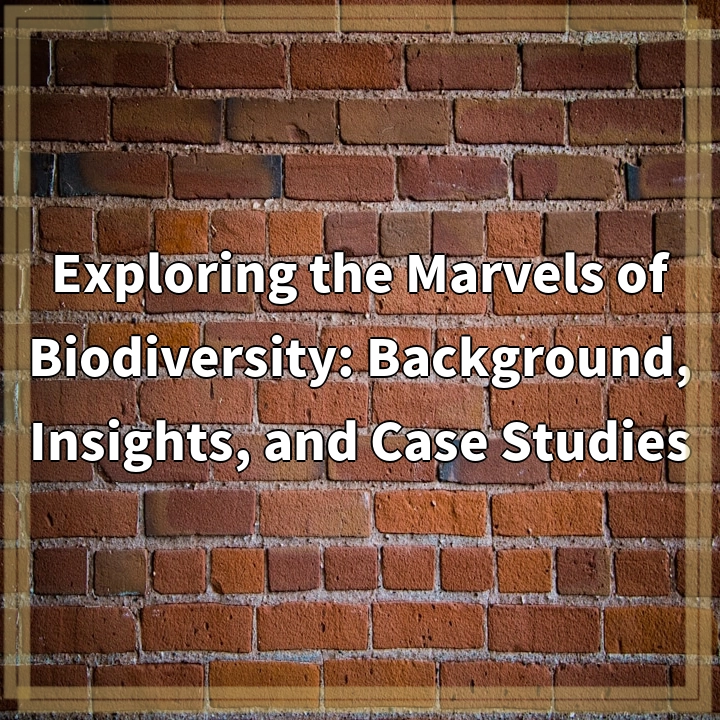Physical Address
304 North Cardinal St.
Dorchester Center, MA 02124
Physical Address
304 North Cardinal St.
Dorchester Center, MA 02124

Biodiversity is the term used to describe the vast array of life on our planet. It encompasses all living organisms, their habitats, and the ecological processes that sustain them. From plants and animals to microorganisms and fungi, biodiversity encompasses the incredible diversity of species, as well as the genetic diversity within each species.
1. Habitat Loss and Fragmentation: One of the most significant threats to biodiversity is the loss and fragmentation of natural habitats. As human populations expand and urbanize areas, natural habitats are destroyed or degraded. This loss of habitat leads to fragmentation, making it difficult for many species to survive as they rely on interconnected ecosystems for resources, breeding, and migration.
2. Species Extinction: Human activities such as deforestation, pollution, overhunting, and the introduction of invasive species have caused a sharp increase in species extinction rates. The loss of even a single species can have cascading effects on entire ecosystems, disrupting ecological balance and reducing genetic diversity.
3. Climate Change: Rapid climate change poses a significant threat to global biodiversity. Shifting temperatures, changing precipitation patterns, and rising sea levels influence the distribution and abundance of species. Many species struggle to adapt to these changes, resulting in range contractions, altered migration patterns, and increased competition for resources.
4. Pollution and Contamination: Pollution from industrial activities, agricultural runoff, and plastic waste poses a severe threat to biodiversity. Chemical pollutants can contaminate water bodies, soil, and air, harming both terrestrial and aquatic ecosystems. This disruption can lead to the decline of sensitive species, disrupt food webs, and contribute to the spread of diseases.
5. Overexploitation and Illegal Wildlife Trade: Overexploitation, including overfishing, poaching, and illegal wildlife trade, has pushed many species to the brink of extinction. Unsustainable fishing practices threaten not only targeted species but also harm entire marine ecosystems. The demand for exotic pets, body parts, and traditional medicines fuels the illicit trade of endangered species, further endangering their populations.
1. Habitat Conservation and Restoration: It is crucial to protect and restore natural habitats. This includes establishing protected areas, national parks, and wildlife reserves. Restoration projects, such as reforestation and wetland rehabilitation, can help recreate lost habitats and promote biodiversity recovery.
2. Species Protection and Management: Implementing measures to protect endangered species is vital. This involves enacting and enforcing wildlife conservation laws, cracking down on illegal wildlife trade, and supporting initiatives for species recovery, such as captive breeding and reintroduction programs.
3. Sustainable Resource Management: Adopting sustainable practices in sectors like forestry, fisheries, and agriculture is essential to minimize negative impacts on biodiversity. This includes promoting sustainable logging, implementing responsible fishing practices, and supporting organic farming methods that conserve soil and water resources.
4. Climate Change Mitigation and Adaptation: Addressing climate change is crucial for protecting biodiversity. This requires reducing greenhouse gas emissions through transitioning to clean energy sources, promoting energy efficiency, and supporting reforestation initiatives. Additionally, implementing adaptation strategies to help ecosystems and species adjust to changing conditions is important.
5. Education and Awareness: Raising public awareness about biodiversity and its importance is vital. Education programs and campaigns can help foster a greater understanding of the value of biodiversity and encourage individuals to take action to protect it. Engaging communities and stakeholders through outreach programs and citizen science initiatives can also contribute to conservation efforts.
By implementing these solutions and fostering collaborative efforts, we can combat the challenges associated with biodiversity loss and pave the way for a sustainable and biodiverse future.
Protecting and conserving biodiversity is not just about preserving the beauty and wonder of our planet. It is about maintaining the balance of ecosystems, ensuring sustainable natural resources for future generations, and safeguarding the delicate web of life that sustains us all. Let us join hands in our efforts to explore and protect the marvels of biodiversity.
If you’re wondering where the article came from!
#